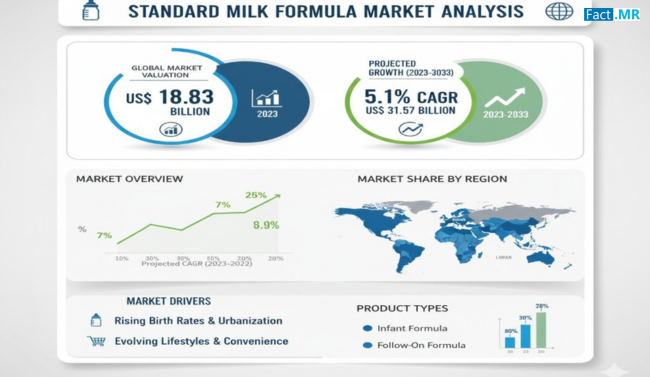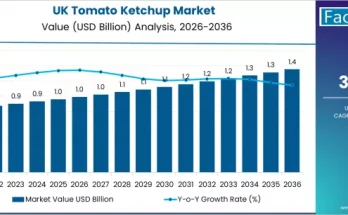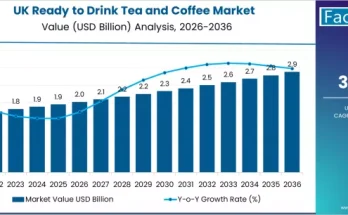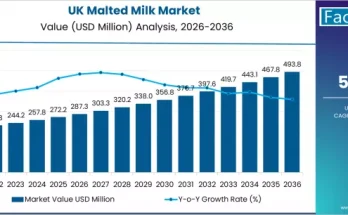The Standard Milk Formula Market is evolving as a critical segment of the global infant nutrition industry. Standard milk formula, commonly referred to as infant formula, serves as a nutritionally balanced alternative to breast milk for infants who are not breastfed or require supplementation. With rising awareness about infant nutrition, an increasing number of working mothers, and changing societal attitudes, the demand for standard milk formula is expanding steadily across the globe.
Market Overview
Standard milk formula is designed to replicate the nutritional profile of breast milk, containing essential proteins, carbohydrates, fats, vitamins, and minerals required for healthy infant growth and development. The market offers a variety of product types, including liquid formula, powder formula, concentrate formula, and ready-to-feed formula, each catering to different convenience and storage needs. Powdered formulas, in particular, have gained popularity due to their shelf stability, cost-effectiveness, and ease of global distribution.
Manufacturers are continually innovating to enhance formula quality, introducing ingredients such as probiotics, human milk oligosaccharides, and plant-based components. These improvements ensure that infant formulas are safe, digestible, and as close as possible to natural breast milk.
Regional Insights
North America remains a leading market for standard milk formula, driven by high awareness of infant nutrition and a significant number of working mothers seeking convenient feeding alternatives. The United States, in particular, reflects strong adoption rates due to supportive healthcare infrastructure and changing cultural attitudes toward formula feeding.
Europe closely follows, with countries like the United Kingdom witnessing a shift in societal norms and increasing workforce participation among women. In Asia-Pacific, rapid urbanization and rising disposable incomes in countries such as China, Japan, and South Korea have fueled demand for reliable infant feeding solutions. Growing awareness about infant health and nutrition, combined with economic growth, is driving the adoption of standard milk formulas in the region.
Key Trends & Forecast
Several key trends are shaping the standard milk formula market:
- Increasing Number of Working Mothers: As more women participate in the workforce, formula feeding has become a practical alternative, offering convenience and flexibility.
- Shift Toward Clean-label and Plant-based Ingredients: There is rising consumer preference for organic, plant-based, and clean-label formulas that are perceived as safer and more natural.
- Product Innovation: Companies are developing specialized formulas tailored to infants with digestive sensitivities or allergies, enhancing product differentiation.
- Education and Awareness: Efforts by healthcare professionals and infant nutrition campaigns have helped normalize formula feeding and highlight its nutritional adequacy.
The market is expected to continue growing as manufacturers innovate, expand product portfolios, and improve accessibility to high-quality formulas worldwide.
Applications & End-Use Outlook
Standard milk formula is widely used across several infant care scenarios:
- Primary Infant Nutrition: For infants unable to breastfeed exclusively, standard formula provides complete nutrition.
- Supplementary Feeding: Formula can complement breast milk when additional nutritional support is needed.
- Specialized Nutrition: Certain formulas cater to infants with digestive issues, lactose intolerance, or other health requirements.
The growing adoption of formula feeding reflects changing family dynamics, lifestyle choices, and parental preferences for convenient, safe, and nutritionally adequate feeding options.
Challenges & Barriers
Despite strong demand, the market faces several challenges:
- Cultural Perceptions: In some regions, breastfeeding remains the preferred norm, and formula feeding may encounter resistance.
- Regulatory Compliance: Manufacturers must adhere to strict safety, labeling, and quality standards across different countries.
- Cost Considerations: While powdered formulas are cost-effective, liquid and ready-to-feed variants can be expensive, limiting accessibility in low-income regions.
Addressing these challenges requires education, regulatory alignment, and product innovations that balance quality, safety, and affordability.
Competitive Landscape
The standard milk formula market is highly competitive, with leading players such as Nestlé, Danone, Abbott Nutrition, The Kraft Heinz Company, Mead Johnson, Pfizer Nutrition, Royal Friesland Campina, DePaul Industries, and Humana GmbH. These companies focus on product innovation, quality assurance, marketing, and strategic collaborations to maintain market leadership. Efforts include developing formulas closer to breast milk, creating plant-based options, and expanding distribution channels globally.
Conclusion
The standard milk formula market is set to remain a crucial pillar of the global infant nutrition landscape. Rising working populations, changing cultural attitudes, increasing awareness about infant health, and product innovation are driving sustained growth. Manufacturers who prioritize safety, quality, innovation, and accessibility will be best positioned to serve evolving consumer needs. As infant nutrition continues to gain attention worldwide, standard milk formulas will play an increasingly important role in supporting infant health, parental convenience, and overall societal well-being.



